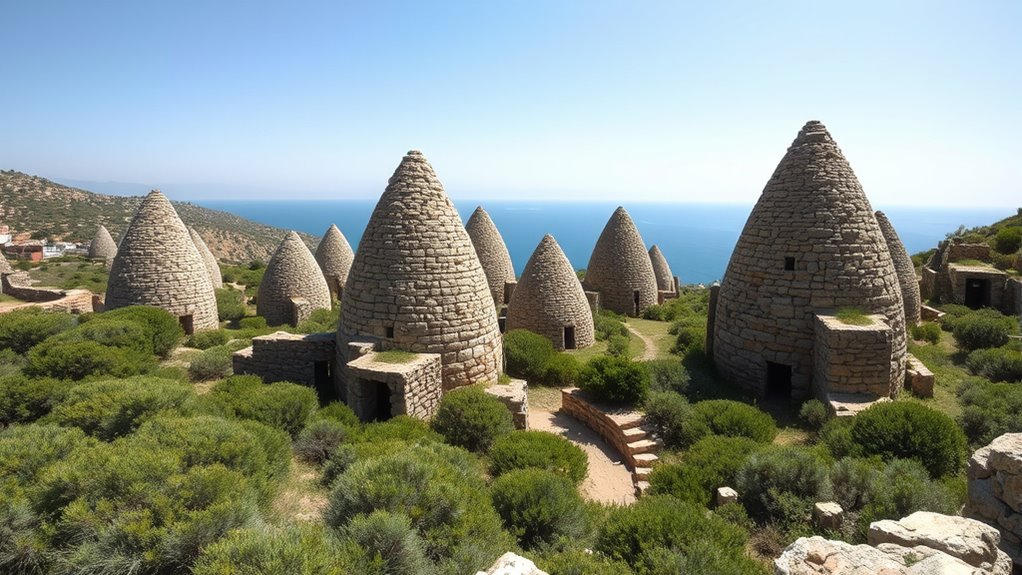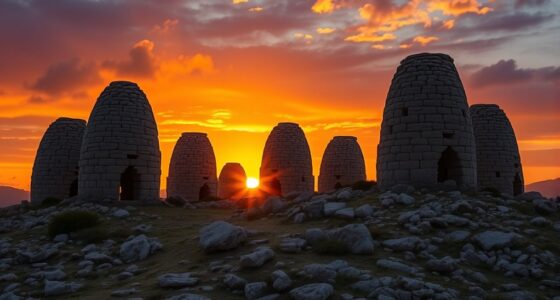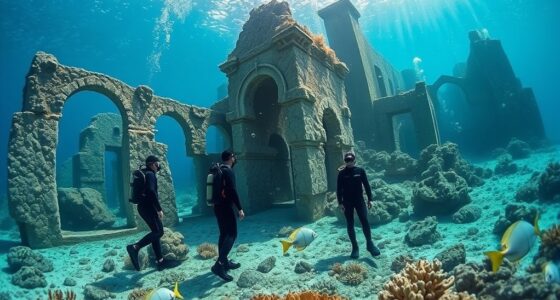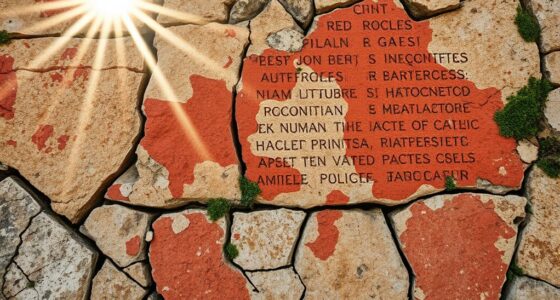The ancient Nuragic civilization of Sardinia, starting around 1800 BCE, is famous for its distinctive stone towers called nuraghi, built without mortar. This society thrived during the Bronze Age, developing advanced architecture, complex social and religious practices, and engaging in maritime trade across the Mediterranean. Their unique megalithic tombs and ongoing cultural traditions reveal a rich heritage that continues to shape Sardinian identity today. Discovering their history offers a fascinating look into one of Europe’s most intriguing ancient societies.
Key Takeaways
- The Nuragic civilisation in Sardinia (c. 1800–500 BCE) is known for constructing distinctive megalithic nuraghi towers.
- It developed from pre-Nuragic cultures, reaching its peak during the Late Bronze Age with advanced stone architecture.
- Society was organized hierarchically, with nuraghi serving as defense, social, and religious centers.
- Extensive trade links connected Nuragic Sardinia to Mycenaean, Phoenician, and other Mediterranean civilizations.
- Recognized as a UNESCO World Heritage Site, Nuraghi symbolize Sardinia’s rich cultural identity and technological achievement.
Origins and Chronology of the Nuragic Society
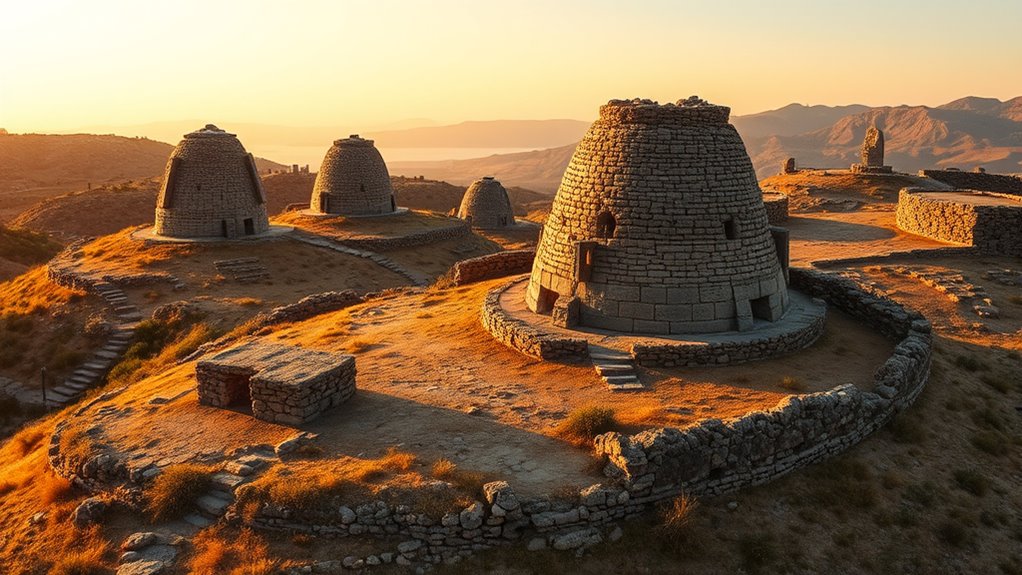
The origins of the Nuragic society trace back to indigenous populations that settled in Sardinia thousands of years ago, evolving from pre-Nuragic cultures like Abealzu-Filigosa, Monte Claro, and Bonnanaro. These early groups laid the foundation for a society that developed through cultural continuity, blending local traditions with Mediterranean influences. Around 1800 BCE, the first nuraghi appeared, marking the start of extensive megalithic construction. The society reached its peak during the Late Bronze Age, from about 1600 to 930 BCE, thriving for roughly a thousand years. Despite Sardinia’s relative isolation, the Nuragic people engaged in Mediterranean trade, exchanging goods and ideas. Their distinct societal identity emerged through unique artifacts, warrior representations, and complex social structures, leaving a lasting legacy in the island’s archaeological landscape. Genetic studies suggest that they had connections with populations from Iberia and other parts of Europe, indicating complex interactions across the Mediterranean region.
Architectural Marvels: Nuraghi and Megalithic Tombs
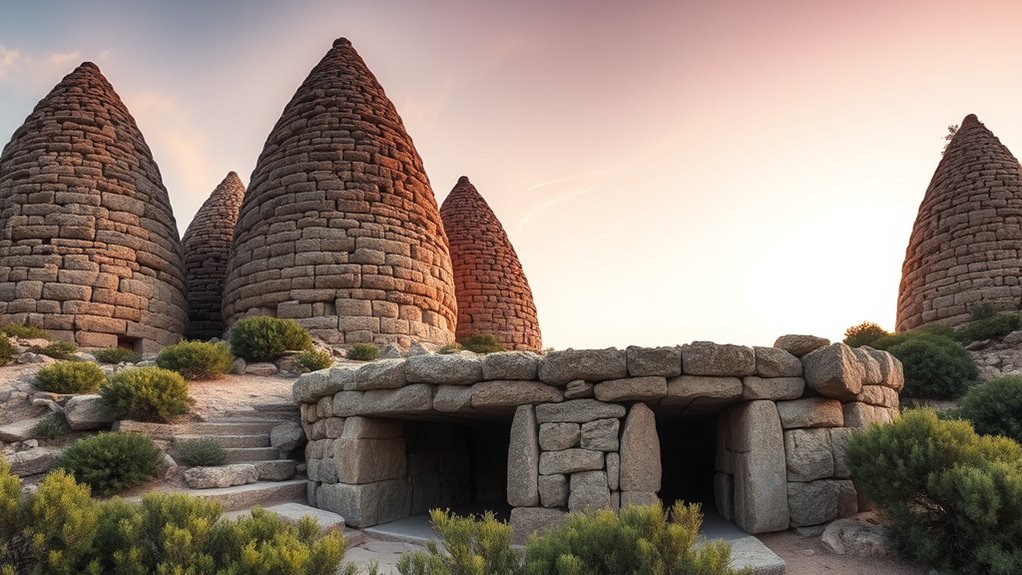
You’ll notice that Nuraghi are impressive dry stone towers built without mortar, using carefully placed stones to create their distinctive shapes and heights. Their complex designs often feature central chambers, surrounding walls, and multiple towers, reflecting advanced architectural planning. Megalithic tombs, or “giants’ graves,” showcase skillful stoneworking with large slabs for collective burials, highlighting the civilization’s mastery of megalithic construction. Additionally, the support hours for archaeological sites can vary seasonally, affecting visitor access and experience.
Nuraghi Construction Techniques
Ancient Nuragic builders employed sophisticated construction techniques that have left us in awe of their engineering prowess. They relied on local limestone and basalt, carefully selecting large, uniform stones shaped by skilled artisans for tight-fitting joints without mortar. Smaller stones reinforced structures and finished details. Using dry stone masonry, they achieved stability through precise placement and interlocking stones, with corbelling used for vaulted ceilings and passageways. Multi-level spaces were created by overhanging stone rows, ensuring durability against time and environment. The following table summarizes their construction methods: building techniques
| Material & Selection | Structural Techniques |
|---|---|
| Local limestone, basalt | Dry stone, interlocking |
| Large, uniform stones | Corbelling for vaults |
| Shaped by artisans | Multi-level overhangs |
| Smaller stones for reinforcement | No mortar needed |
| Quarrying logistics | Resilient, enduring structures |
Tower Complex Designs
What makes Nuragic tower complexes stand out as architectural marvels is their sophisticated dry-stone construction and symbolic design. These towers, or nuraghi, are truncated cones built without mortar, showcasing advanced understanding of weight distribution and structural stability. Their beehive-shaped interiors and medieval-like exteriors reach heights of up to 30 meters, demonstrating remarkable engineering skill. Many nuraghi are part of larger complexes, surrounded by protective walls and settlements, reflecting their strategic and social importance. The quality of stonework varies, revealing evolving techniques and resource management. These structures likely served multiple functions: defense, community identity, or ceremonial purposes. Their precise construction and impressive scale highlight a sophisticated architectural tradition, emphasizing stability, symbolism, and the capacity to mobilize extensive resources. The construction techniques required extensive community effort and technical knowledge, indicating well-organized social structures. Additionally, the integration of symbolic elements suggests a deep cultural significance intertwined with their architectural design.
Megalithic Tomb Features
Have you ever wondered how prehistoric builders created such enduring and monumental burial structures? Nuragic megalithic tombs, like the Giant’s Tombs, stretch up to 30 meters long, with central chambers covered by massive slabs. These chambers often feature vaulted or corbelled “False domes” reaching heights of 7 to 12 meters. The tombs’ façades display large, symmetrically arranged stones, with central steles marking entrances—sometimes carved with symbolic motifs. Forecourts serve as communal ritual spaces, emphasizing their dual burial and ceremonial roles. Builders relied on precise dry-stone techniques, fitting massive limestone or granite blocks without mortar, ensuring stability over millennia. Some tombs align with celestial or environmental cues, reflecting their integration with natural surroundings and spiritual significance. The use of masonry techniques demonstrates advanced engineering skills, allowing these structures to withstand the test of time and remain as architectural marvels.
Societal Structure and Cultural Practices

The Nuragic society was organized hierarchically, with clear social distinctions that grew more pronounced during the Bronze Age. Society was mostly tribal and rural, centered around nuraghi that marked power and wealth within districts called “cantoni.” Large elite households inhabited fortified nuraghi compounds, supported by surrounding villages. Politically, structures were decentralized, with nuraghi systems cooperating rather than opposing each other. Nuraghi served multiple roles: defense, residence, social gatherings, and religious activities, often near sacred sites. Burial practices shifted from collective to individual graves, highlighting social stratification. Religious practices involved sacred wells and cosmic rituals. The development of complex religious beliefs and practices reinforced social cohesion and spiritual authority within Nuragic communities. Additionally, the presence of specialized artifacts and ritual objects indicates the development of religious rituals that helped maintain social and spiritual order.
Environmental and Social Changes in the Bronze Age
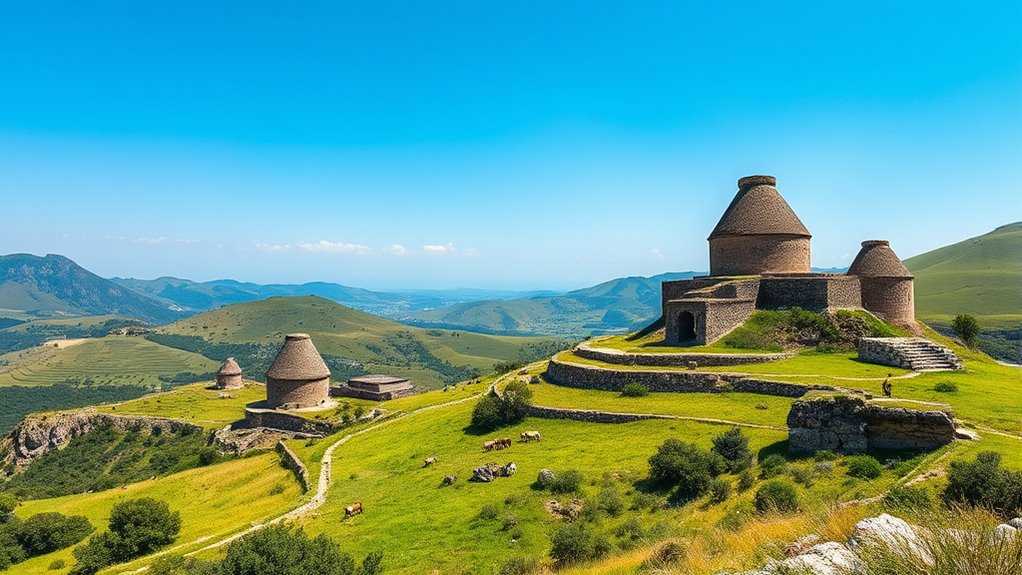
During the Bronze Age, environmental conditions on Sardinia underwent significant changes that shaped societal development. Climate shifts around the 13th century B.C. disrupted Nuragic architecture and prompted ecological transformations, as later Bronze Age analyses reveal. Speleothem isotope studies show discontinuities in rainfall and temperature, affecting resources and agriculture. These pressures likely led to more complex settlements with strategic layouts, water access, and defensive features, reflecting adaptation to environmental stresses. Sardinia’s rich metal deposits fueled advanced metallurgy, but resource pressures from climate fluctuations influenced trade and raw material use. Communities practiced mixed farming and pastoralism, adjusting their landscape management to the changing terrain. These environmental and social shifts contributed to increased settlement nucleation and societal resilience amid ecological challenges. Additionally, evidence of social organization suggests a restructuring of community roles and leadership in response to environmental pressures.
Interactions With Mediterranean Civilizations
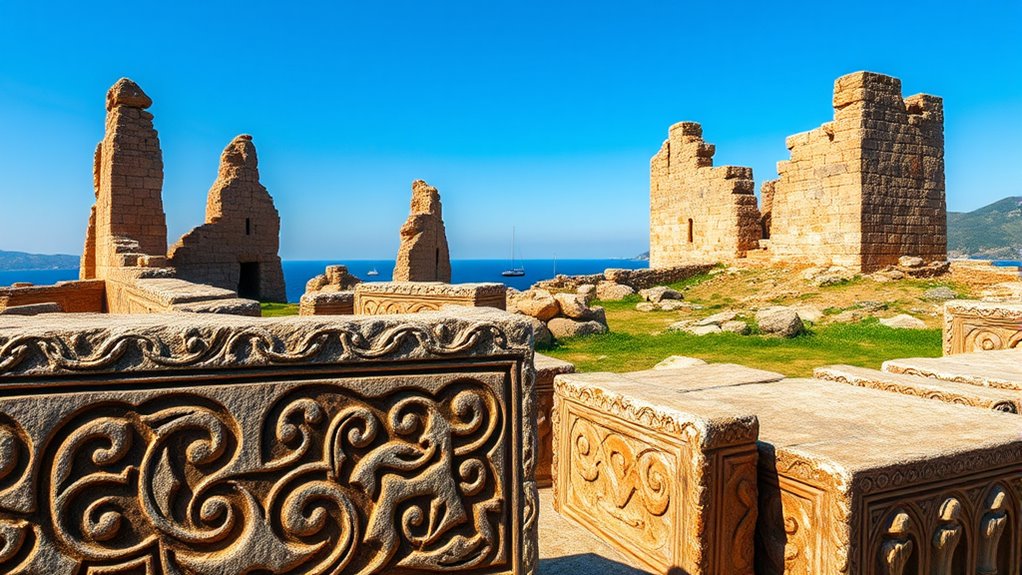
Sardinia’s strategic position in the Mediterranean made it a hub for extensive maritime trade and cultural exchange. You can see this through the artifacts found in Nuragic sites, such as bronze, copper, textiles, and ceramics, linking Sardinia to Mycenaean, Phoenician, Etruscan, and Carthaginian civilizations. Nuragic products have been discovered across the Mediterranean, confirming outward trade. Some scholars associate the Nuragic people with the Sea Peoples, especially the Sherden tribe, known from Egyptian records. Nuragic ceramics dating to the 13th century BCE have been found at Tiryns and Cyprus, hinting at direct contact or presence. Their maritime activity possibly influenced regions as far as Israel, reflected in architecture and archaeological finds. Additionally, the maritime trade routes facilitated not only economic exchange but also the transfer of ideas and cultural practices across the Mediterranean.
Archaeological Discoveries and Research Highlights
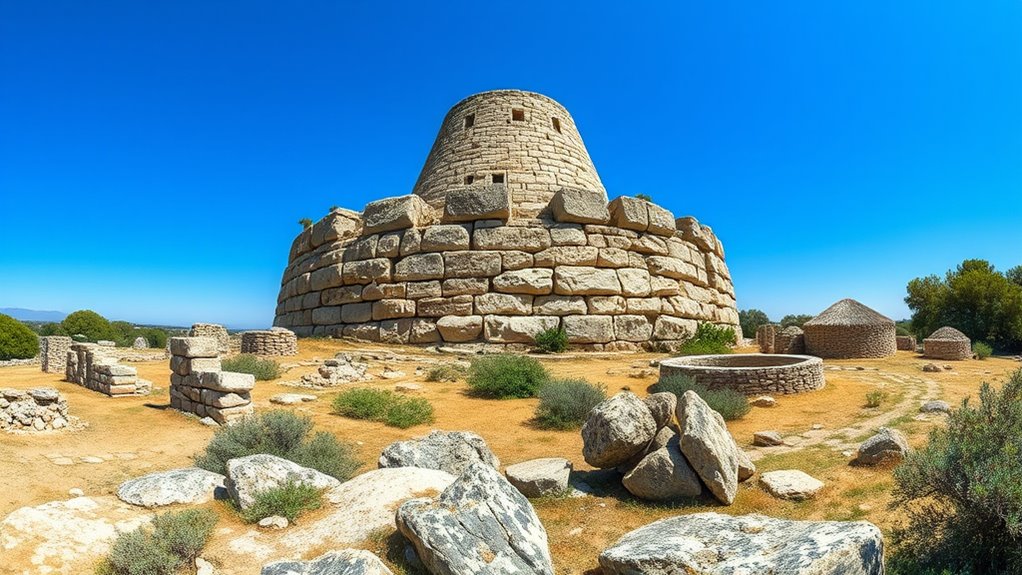
Recent excavations have uncovered new insights into Nuragic construction, clarifying how the timeline of building techniques evolved over centuries. These discoveries reveal a richer understanding of their cultural development and social organization. As research continues, you’ll see how each find adds to the picture of this fascinating ancient civilization. The findings also suggest that the Nuragic society may have experienced periods of technological innovation alongside traditional methods. Additionally, detailed analysis of artifacts has provided clues about their architectural innovations and adaptation strategies over time.
Recent Excavation Finds
Excavations have uncovered remarkable underwater nuraghi in the shallow waters of Cabras Lagoon, revealing a previously unknown extension of Sardinia’s nuragic network. These submerged structures, dating from approximately 1500–500 BC, were deliberately built in aquatic environments, possibly for symbolic or strategic maritime purposes. Using advanced tools like sonar mapping and remote-operated vehicles, researchers have documented these impressive formations, expanding our understanding of nuragic reach beyond land. Recent studies show these nuraghi feature typical truncated conical shapes, inner tholos chambers, and interconnected towers with defensive walls. The findings highlight the civilization’s adaptability, suggesting they used lagoons for both ritual and practical activities. This discovery, combined with ongoing research at UNESCO sites like Su Nuraxi, underscores the dynamic relationship between Nuragic people and their environment. The deliberate placement of nuraghi in shallow waters may also indicate a sophisticated knowledge of maritime navigation and resource management maritime navigation and resource management. Furthermore, the strategic location in aquatic settings may reflect water-related cultural or economic significance, demonstrating the Nuragic people’s intricate understanding of their environment.
Construction Timeline Clarifications
The construction of nuraghi unfolded over several centuries, reflecting the evolving social and technological landscape of the Nuragic civilization. You can see this progression in the timeline from early protonuraghi around 1800 BC, which were simple towers, to the complex, multi-chambered structures during the Middle Bronze Age (~1500-1100 BC). After 900 BC, no new nuraghi appeared; existing ones were often renovated or repurposed for sacred or communal uses. This timeline aligns with societal development, settlement expansion, and increasing defensive needs. Here’s a quick overview:
| Phase | Approx. Date Range | Focus |
|---|---|---|
| Protonuraghi | 2000–1800 BC | Basic structures |
| Middle Bronze Age | 1500–1100 BC | Architectural refinement |
| Iron Age | post-900 BC | Renovation, repurposing |
Additionally, ongoing archaeological research continues to shed light on the construction techniques and societal significance of these ancient structures.
Cultural Insights Unveiled
Have you ever wondered what archaeological discoveries reveal about the rich culture of the Nuragic civilization? Recent finds highlight their ingenuity, like the submerged nuraghi in the Cabras Lagoon, showing their environmental connection. The Tiscali Village, built inside a sinkhole, demonstrates advanced construction skills, while the Sanctuary of Santa Vittoria reveals evolving religious practices through bronze artifacts. Nuraghi served multiple purposes—fortresses, worship sites, and community centers—often strategically placed in hilltops. Artifacts like bronze figurines, necklaces, and symbolic objects reveal a sophisticated craftsmanship and extensive trade links with cultures like the Etruscans and Phoenicians. These discoveries paint a picture of a resilient society rooted in agriculture, community, and cultural exchange, providing profound insights into the complex Nuragic civilization of Sardinia. The site also features a sacred well and a feast enclosure, emphasizing its role as a religious and social hub across different periods.
The Symbolism and Legacy of Nuragic Monuments

Nuragic monuments embody more than impressive architecture; they serve as powerful symbols of Sardinia’s cultural identity and spiritual beliefs. Their design showcases advanced engineering skills, with thick stone walls and geometric shapes like triangles and circles, emphasizing both security and spiritual meaning. Nuraghi also represent Sardinia’s distinct heritage, standing apart from other regions. Many served as defensive structures, offering strategic vantage points, while others had social or religious functions, like sacred wells and giant’s tombs. Their enduring presence symbolizes the island’s rich history and reverence for ancestors. Today, these monuments continue to inspire pride and recognition, with UNESCO’s inscription of Su Nuraxi underscoring their global importance. They remain key icons of Sardinia’s cultural legacy, linking past traditions to contemporary identity. Over 7,000 nuraghi structures are present in Sardinia today, highlighting the widespread significance and continued admiration for these ancient sites.
Nuragic Culture in Contemporary Sardinia
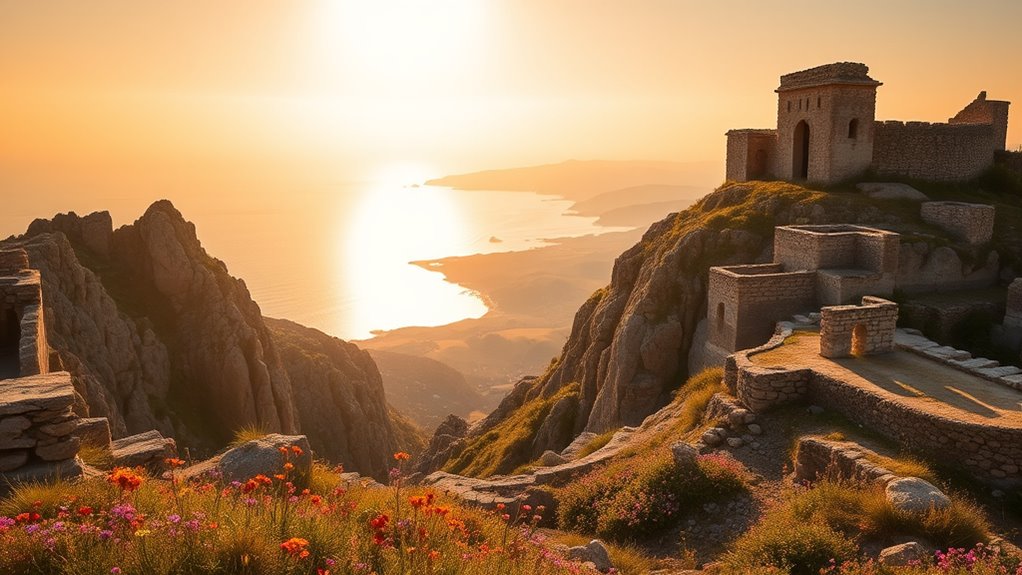
Ancient Nuragic monuments continue to shape how Sardinians see themselves today, serving as living symbols of their unique cultural identity. You’ll find that the Sardinian language is actively preserved, keeping alive the ties to Nuragic roots. Local festivals still incorporate traditions from the Nuragic era, blending ancient practices with modern life. Many Sardinians feel a strong connection to their island’s past, which boosts their pride and sense of belonging. Traditional crafts and metalworking skills, inspired by Nuragic bronze artifacts, are still practiced and celebrated. Nuragic themes appear frequently in contemporary art and symbolism, reinforcing Sardinia’s cultural distinctiveness within Italy and Europe. Over 12,000 Nuragic sites remain integral to daily life, tourism, and education, highlighting their enduring significance in Sardinian culture. These sites continue to attract researchers and visitors alike, further cementing their importance in understanding Sardinian history.
Preserving the Heritage: UNESCO and Cultural Significance
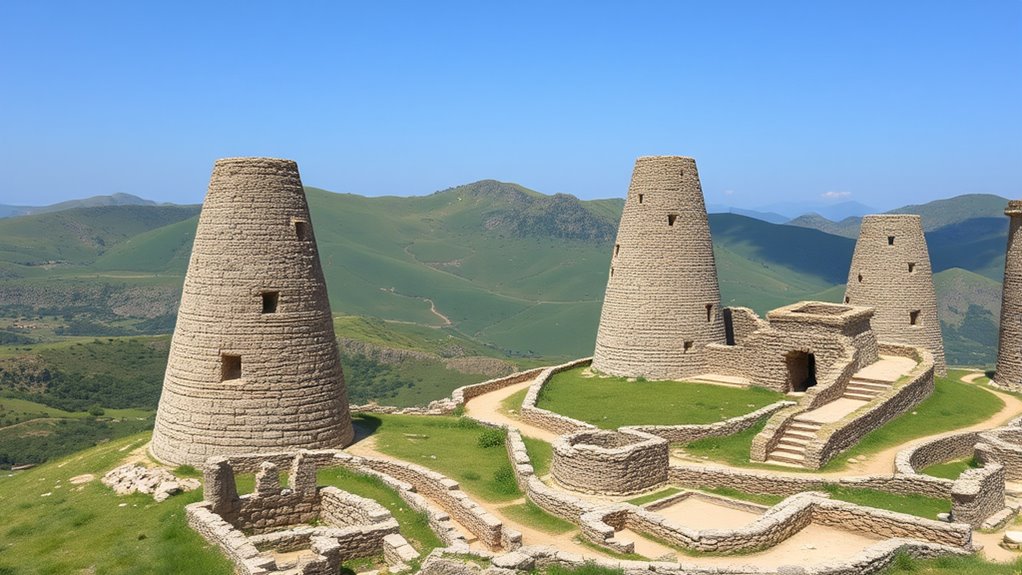
The designation of Su Nuraxi di Barumini as a UNESCO World Heritage Site in 1997 marked a significant milestone in safeguarding Sardinia’s prehistoric legacy. This recognition highlights Su Nuraxi as an extraordinary example of prehistoric architecture, showcasing innovative materials and techniques. The listing includes extensive ruins, such as a central tower, four corner towers, a bastion, and a nearby village inhabited from the 17th to 6th century BCE. UNESCO emphasizes Su Nuraxi’s importance in illustrating the complexity of Nuragic society and technological progress. Efforts now aim to expand protection to around 30 Nuragic sites, including nuraghi, villages, temples, and tombs across Sardinia. These initiatives help preserve a crucial part of Sardinia’s cultural identity and ancient history.
- Recognition of Su Nuraxi’s architectural innovation
- Broader protection for Nuragic monument groups
- Conservation efforts amid natural and human threats
- Promotion of Sardinia’s prehistoric cultural legacy
Frequently Asked Questions
How Did Nuragic Society Organize Its Daily Life and Governance?
You see, daily life in this society revolves around farming, herding, fishing, and crafts like pottery and metalwork. Governance is organized through tribal leaders managing clusters of nuraghi and territories, with roads ensuring communication. Religious practices, centered on holy wells and temples, reinforce community bonds. Property and wealth tie to livestock and land use, while rituals and communal spaces strengthen social cohesion and spiritual life, creating a well-structured society.
What Were the Specific Religious Beliefs Associated With Nuragic Structures?
Imagine stepping into a world where sacred symbols breathe life into stone. You’d see the bull representing fertility and solar power, and the dove symbolizing peace. You’d witness rituals around water, fire, and celestial alignments, connecting gods to natural cycles. Sacred wells, tombs, and temples weren’t just buildings—they were the heartbeat of spiritual beliefs, embodying divine forces of water, sun, moon, and ancestral power in every stone.
How Did Climate Changes Influence Nuragic Settlement Patterns?
You see, climate changes considerably shaped settlement patterns by forcing you to adapt resource management and location choices. You would strategically place settlements near water sources and develop infrastructure like wells and cisterns for sustainable water use. As environmental conditions shifted, you might have altered settlement layouts, clustering or dispersing sites based on terrain and climate. These adaptations helped you maintain communities despite fluctuating climate and resource pressures.
Are There Any Known Nuragic Written Records or Symbols?
You wonder if there are any known written records or symbols from this culture. Currently, you find no evidence of a developed writing system or extensive inscriptions. The society relied mainly on oral traditions and symbolic art, like carvings and sculptures, to communicate religious and social ideas. While some short marks exist, they’re not well understood. So, you won’t find a true script, only symbolic representations.
How Do Nuragic Sites Compare With Contemporary Mediterranean Civilizations?
You compare Nuragic sites to their Mediterranean contemporaries through their unique architecture, strategic defense, and technological innovation. You notice their massive nuraghes stand apart from more open palaces or temples, emphasizing strength and community cohesion. You see their advanced agriculture, broad trade networks, and maritime contacts rivaling other civilizations. You recognize their military prowess, with warrior depictions and possible involvement in regional conflicts, highlighting a distinctive, resilient, and interconnected society.
Conclusion
As you explore the ancient Nuragic civilization, you glimpse a timeless tapestry of ingenuity and cultural richness woven into Sardinia’s landscape. Their enduring monuments whisper stories of a society that thrived in harmony with nature and each other. By preserving these sacred remnants, you help keep their legacy alive, inviting future generations to appreciate the gentle beauty and silent wisdom of a civilization that continues to inspire wonder and reflection.
